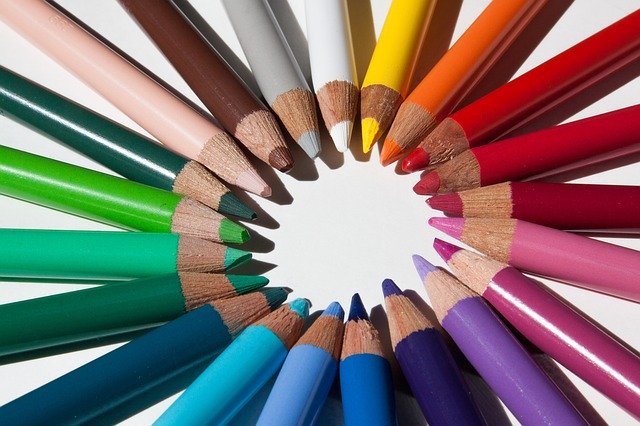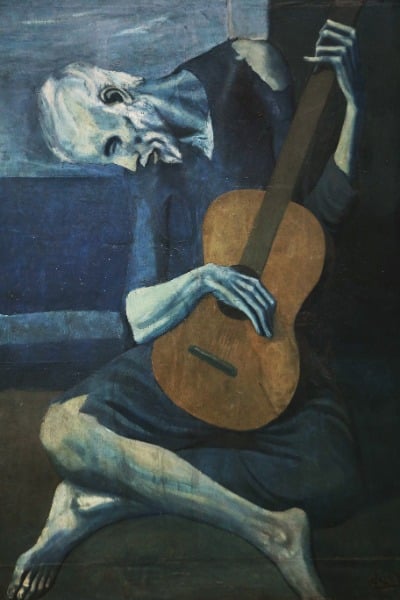Three Colors That Look Good in a Art Work
Do colors e'er make yous feel warmer or cooler? Certain they do! If you step into a room filled with yellows and oranges you are certain to get-go feeling warmer. Conversely, if you stepped into a room filled with blues you lot would beginning to feel much cooler. In this way from the relationship of warm and absurd colors, we go a sense of color temperature past a visual ways vs color temperature in the physical metric of hot and cold.
In this post I will give a thorough overview of what warm and absurd colors are in fine art and how you tin can utilise them to greatly ameliorate your ain painting!
Contents of this Commodity
- What are warm and absurd colors?
- Relativity of warm and cool colors
- Never think of color temperature as absolute
- The importance of colour temperature in art
- Color temperature and the illusion of space
- The illusion of course with the help of color temperature
- Examples of warm and cool colors in art
- Summary of warm vs absurd colors
What are warm and cool colors?

Warm colors are made up of colors such as reds, oranges and yellows. While cool colors consist of blue, regal and greens and the shades off of those that are libation in color temperature. Allow's take a look at the color wheel chart above. You will notice that virtually of the colors on the left side of the color bike are cool colors, while virtually of the colors on the right are warm colors. The result of this color circle depiction, gives us the sense of a thermometer to judge the color temperature of warm vs absurd colors.
Relativity of warm and cool colors
At present one cannot ever say that every blue is always a cool color and every ruby-red is a warm colour. There is a lot of relativity when it comes to color temperature. For example there can be warm blues, absurd reds and warm greens.
A cool color such as bluish can be fabricated warmer be getting mixed with a warm color such as ruby. While a warm color such every bit yellowish tin can exist made cooler by being mixed with a absurd green.

For example, accept a await at the colour nautical chart higher up. You lot will see yellow, ruddy, blue and green. Each colour has a cool and warm version. A warm yellowish is made by getting mixed with a little cherry, while a absurd red is made by getting mixed with some blue. If you're using oil paints, here's a color mixing guide, that will help y'all with creating dissimilar shades of color.
So, although some colors are typically warm colors and others cool colors. Within each color family at that place can be versions of warm and cool colors. There are unlike warm and absurd blues just similar there are warm and absurd reds.
Never retrieve of colour temperature every bit absolute
From the example in a higher place you will see that ane tin never call up of color in absolute terms because colors do not exist by themselves. Rather they are e'er next to a color. You can only place the temperature of a colour if you have a color to compare it to. I would not exist able to call a yellow a 'cool yellow' if information technology were not next to a 'warm yellow'.
It is not helpful to only country that blue is a cool colour. Certainly if blue is next to red as in the case below we can safely say that the bluish is cooler than scarlet.

However, if you place a blue next to another bluish are they both the aforementioned temperature?

If y'all recollect of color in relative terms and then you will come to see that the first blue is cooler than the second blueish. The 2nd blue has some scarlet mixed in information technology. I can disregard colour relativity and just consider all blues to be cool and all reds to be warm. Withal, your range of possibilities for using temperature in your painting increases dramatically when you starting time to call up of color and temperature in relative terms.
Also, you will be much more attune to subtle contrasts in temperature within a colour. Rather than but contrasting a warm color like scarlet with a absurd color like blueish you will exist able to create subtle contrasts within the blues and reds. When paying attention to subtle temperature shifts in your painting y'all tin start to see some stunning color relationships happen. All great painters were masters at color relativity. You can exist a chief at it too if yous train your heart to notice which colors are cooler or warmer next to each other.
The importance of colour temperature in art
Colour temperature plays a much bigger curl in painting than but make one feel 'cool' or 'warm'.
When you lot are able to command color temperature in your painting you lot can:
- Create a sense of depth (peculiarly in landscape painting)
- Prove dimensionality in your objects
- Integrate a sense of color and light in your painting and a feeling of sunlight
- Present a specific mood
- Create separation and or define relationships between objects and parts of the same subject
Color temperature and the illusion of infinite
Warm and absurd colors play a big role when it comes to creating an illusion of space in your painting. Cool colors tend to recede in space while warm colors advance or come forward. This concept, is i of the great landscape painting tips.
For example, let's say you are looking out at a field and far off in the distance y'all tin can see mountains. You volition discover that what is far away is much libation than the function of the field that is close to y'all. Off in the altitude the field is much libation in color and the mountains (which are furthest) are coolest of all.
Above is a painting by Corot that illustrates colour temperature, as well equally spatial concept quite well. If you look off into the altitude of the painting y'all will meet that the colors are rather cool in comparison to the rest of the painting. The mountains are a blueish colour.
On the other hand, the foreground of the painting consists of warm colors such as; a xanthous red on the left and a xanthous biscuit on the far correct. In add-on the colors that make the colour light-green here, which are in the foreground, are quite warm also.
If you utilize these cardinal temperature and spatial concepts to your paintings. Whether they are landscapes, notwithstanding life paintings or completely abstract, it will give your piece of work a sense of space.
The illusion of form with the help of color temperature
Merely like warm and cool colors can influence the sense of infinite in your painting, they can also aid create an illusion of form. Warm colors tend to expand while absurd colors appear to contract. Sometimes, a cartoon can be correct but the proportions can still look a petty off. If this is e'er the example, try to fix the color temperature. Advisedly observe what you are painting and set your painting (or drawing) accordingly – warm upwards the areas that seems too small and cool down the areas that seem too large.

Examples of warm and cool colors in fine art

To a higher place is an example of warm and cool colors at play in a painting by Peter Paul Rubens. The lips have the warmest color out of them all – a deep rich red. The next warmest colour is the blood-red orange colour of the girls cheek. A color that is cooler than either of the same colors is the cool yellow pink of the forehead. The coolest color of them all is the highlight that is on the upper function of the forehead.

Here is an entirely dissimilar painting from the one past Rubens above. It is for the most part a absurd colored painting as it consists of many unlike shades of blue. The work demonstrates how you can make something stand out hands with temperature. The guitar at the center of the painting is the warmest part of the painting and jumps out at you immediately. If the guitar were blue, it would not stand out near as much as it really does. And then, this slice demonstrates the power of contrasting dissimilar color temperatures confronting one another.
Summary of warm vs cool colors
Here is a epitomize of what we discussed in this article:
- The temperature of a colour is Non absolute. Blue is not always a absurd color and red is non always a warm color.
- The color temperature of your paint is always relative and needs to be adamant in relation to what information technology is next to/ surrounded past.
- Using warm and cool colors tin help create space and dimension in your painting which is especially useful in landscape painting.
- Warm and cool colors tin be used to create illusion of form.
- When paying attention to subtle temperature changes within a colour (for example notice warm and absurd reds) you can achieve stunning subtleties in your work.
Want to remember this? Salvage this Warm and Cool Colors guide to your favorite Pinterest board!

Source: https://artstudiolife.com/warm-and-cool-colors/
0 Response to "Three Colors That Look Good in a Art Work"
Post a Comment